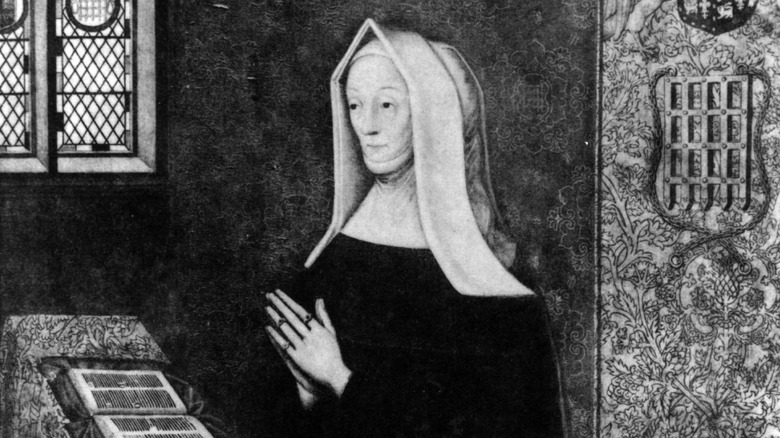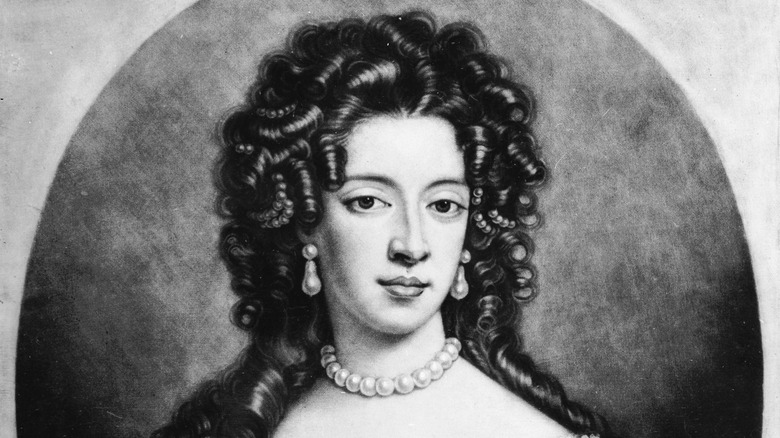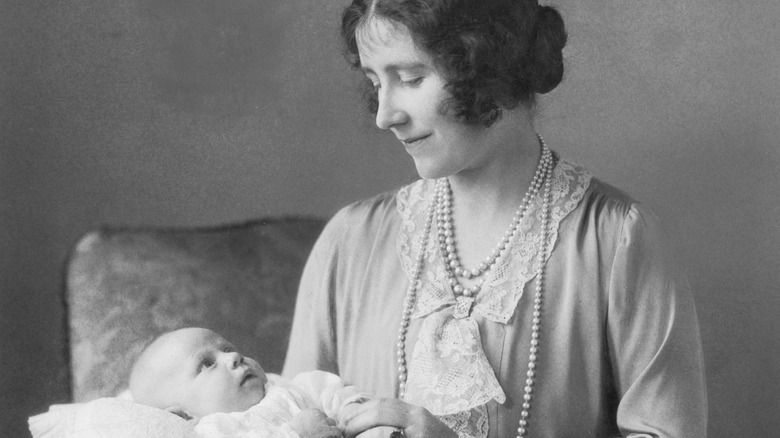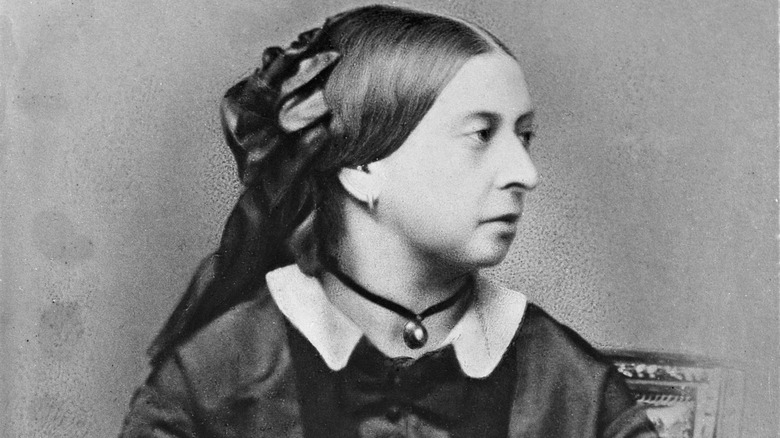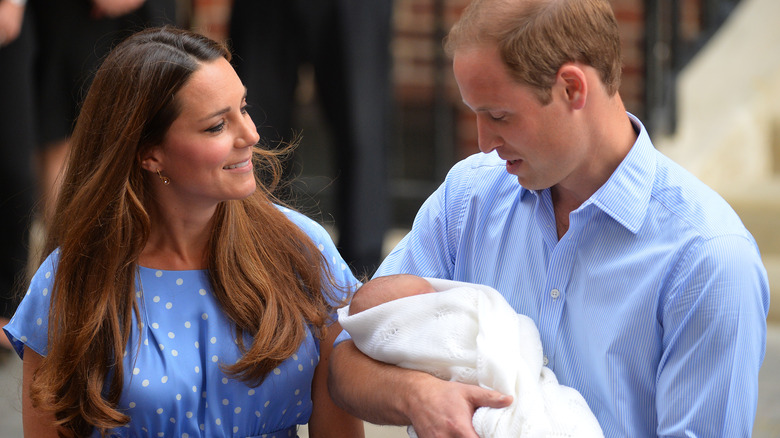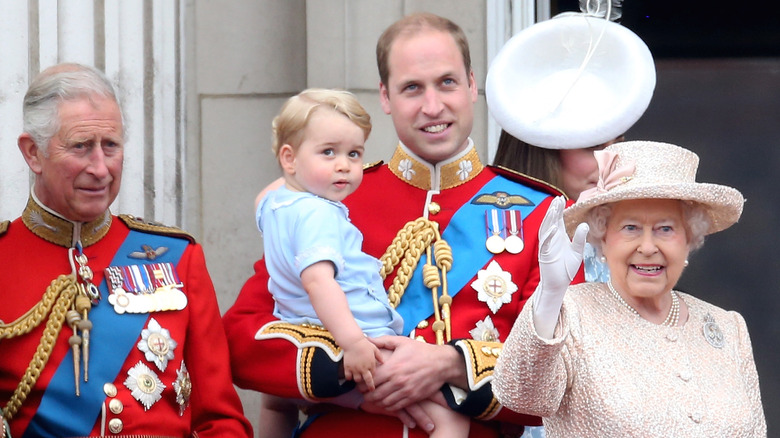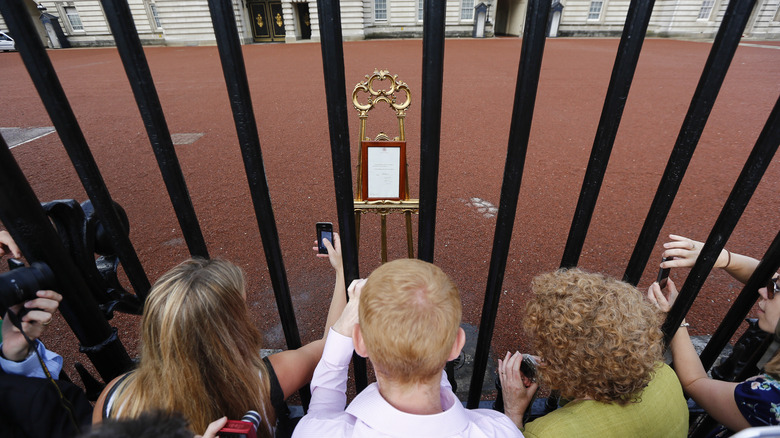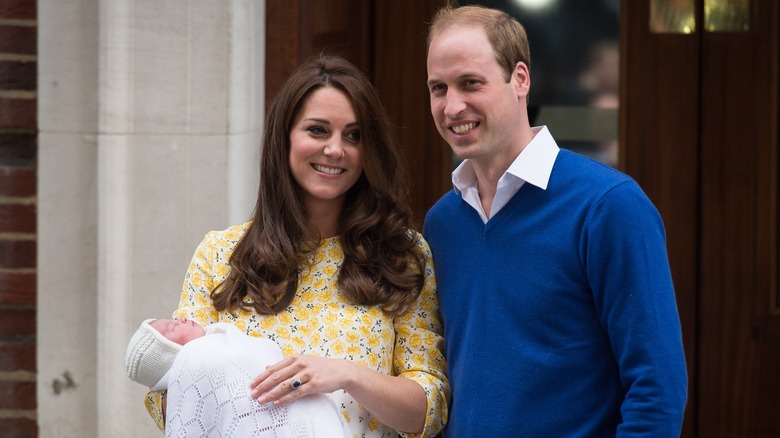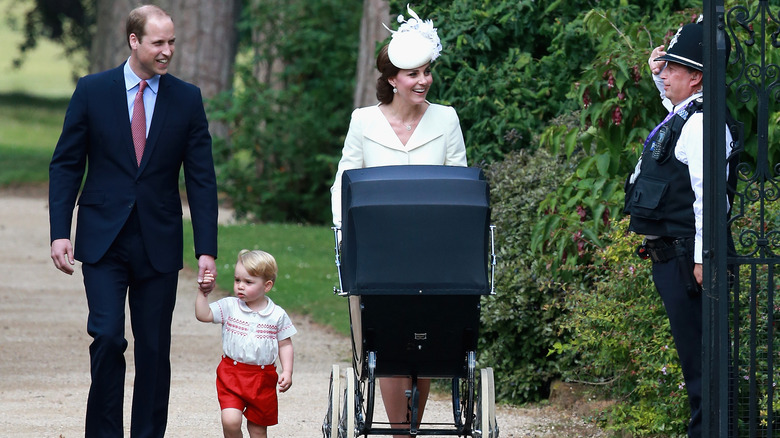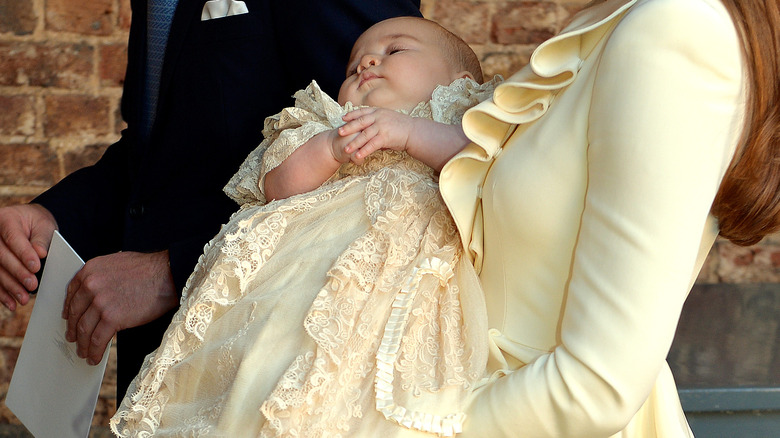The Untold Truth Of Royal Babies
After announcing her third pregnancy in early September 2017, Catherine, the Duchess of Cambridge attended a reception for World Mental Health Day in October. Vogue noted that "Twitter was on full-on bump watch, however, it was impossible...to tell [whether Middleton has a visible baby bump], unsurprising, considering she's reportedly in her first trimester or early in the second."
With all excitement about the next wee royal and when he or she will make a grand entrance, it can be fascinating to see what sorts of traditions have surrounded royal pregnancies and babies — both in the past and today.
Royals used to go to extreme efforts to have a boy
Since female heirs could only take the throne as an absolute last resort — for example, if there were no men in the line of succession — royals used to go all-out in their efforts to ensure that a pregnant queen produced a boy.
Tracy Borman, joint curator of an exhibit at Hampton Court Palace called Secrets of the Royal Bedchamber, told The Daily Telegraph that a series of rules put in place in the 15th century by Margaret Beaufort (mother of Henry VII — who, as you can see, looks like she was a superbly happy and very chill person) laid out some of those extreme measures.
Royal mothers-to-be "could only be served by women, no natural light was allowed, so all the windows were shuttered and even keyholes were blocked up. Fires had to be lit, even in the summer." These rules persisted for centuries because people believed that a baby's gender wasn't set until birth, and that external factors leading up to delivery could influence whether the queen produced a boy or a girl. Talk about things that could make a woman go stir-crazy, or lie there in overheated misery!
Royal births used to have an extensive audience
How's this for awkward: in order to prevent allegations of foul play (such as replacing a stillborn child with a live one), royal births used to have huge audiences. Midwives, doctors, ladies-in-waiting, and courtiers used to crowd into the bedchamber to ensure that no tricky business happened. According to historian and author Carolyn Harris, this tradition began during the reign of James II and his wife, Mary of Modena. All of James and Mary's children had died in infancy until their son, James Francis Edward, was born in 1688 — and throughout Mary's pregnancy, the "Catholic King expressed confidence that the child would be a healthy boy, prompting rumors in Protestant circles that a baby would be smuggled into the delivery room in the event of a daughter or stillbirth."
Trying to put those rumors to rest, James allowed more than 40 courtiers into Mary's bedchamber while she gave birth, thinking that a veritable cornucopia of witnesses would help people know for sure that his wife had birthed a live, healthy baby boy. Despite his efforts, many people believed that James Francis Edward had been smuggled into the room in a warming pan.
As The Telegraph reports, it was all for naught. "James was never accepted by the public because he was born a Catholic, a fact that contributed to the Glorious Revolution which put William III and his wife Mary II (James II's Protestant daughter by his first wife) on the throne in 1689."
More recently royal births included just a handful of VIPs
As Harris notes, after James Edward Francis' birth and subsequent removal, "For all future births of royal heirs until the arrival of Prince Charles in 1948, a government official had to be present to certify that an authentic royal birth had taken place." While not as awkward as an enormous audience of witnesses, it still must have been uncomfortable. The Telegraph reports, "The Archbishop of Canterbury, the Bishop of London and the home secretary of the day were expected to witness the birth, and while the idea of bishops being present died out at the turn of the century, home secretaries witnessed the birth of the Queen and Princess Margaret."
The Telegraph also notes, "When the Queen was born in 1926 Sir William Joynson-Hicks broke off from his ministerial duties to attend the birth, and his successor John Robert Clynes was detained in Scotland for two weeks in 1930 while he waited for the overdue arrival of Princess Margaret at Glamis Castle."
The last royal baby born with a home secretary as a witness was Princess Alexandra of Kent — the Queen's cousin — who was born in 1936. It's not as hideously awkward as a room full of strangers, but knowing that a government official kept tabs on the birth seems like it would've been a tad uncomfortable.
Queen Victoria was the first to use anesthesia
Queen Victoria and her husband Prince Albert had nine children — but, as the BBC reports, she "loathed being pregnant. Repeated pregnancies she considered 'more like a rabbit or a guinea pig than anything else and not very nice.'"
She was pregnant with her sixth child in 1848 when she first requested to use the drug during her own impending labor and delivery, but her doctors deemed it too risky, notes UCLA's Fielding School of Public Health. However, by the time she was ready to deliver the eighth of her nine children in 1853, her doctors' reservations had disappeared, and she was administered chloroform during the birth of Prince Leopold.
As The Guardian writes, "Queen Victoria herself called it 'that blessed chloroform' and its effect 'soothing, quieting and delightful beyond measure.'" In fact, Harris notes that Victoria was pleased "by the comparably comfortable births of her two youngest children and sent bottles of chloroform to her daughters and granddaughters when they were expecting children of their own, transforming royal delivery rooms across Europe." So, ladies, shall we have a moment of silent thanks for the fact that Queen Victoria paved the way for pain management in labor?
Hospitals, and dads in the room, are new things
In a departure from tradition, Anne, Princess Royal, gave birth in a hospital, reports The Washington Post. Until she elected to deliver at St. Mary's Hospital in London, nearly all royal babies had been born at home, and even Queen Elizabeth II — who had been delivered via Caesarean section — was born at her grandparents' home in London, according to the 2002 obituary for the Queen Mother. As The Washington Post notes, "The princess went to the hospital because that was the preference of the queen's gynecologist, Mr. George Pinker. (In Britain, specialists are never called "Dr.") She went to St. Mary's... because Mr. Pinker is a consultant there. Before the birth Pinker said Princess Anne would be treated 'the same as any other patient.'"
In yet another departure from tradition, until recently the baby's father usually wasn't present for the birth. That changed with Prince Charles, according to MSNBC, who broke the tradition of paternal absence when he remained in the room with Princess Diana during Prince William's birth in 1982. Over 30 years later, William chose to be in the room with Kate during her deliveries of both George and Charlotte, and will undoubtedly do the same for baby number three.
There are now three generations of heirs
When Prince George was born in July 2013, it was the first time in 119 years that there were three generations heirs to the throne, reports The Independent. "The last time the monarch met her great-grandson was when Queen Victoria was alive at the same time has her son Edward, his son George, and his son Edward." According to royal biographer Christopher Warwick, speaking with The Independent, "Obviously the great thing is that the new royal birth secures the line of succession for the third generation, which is the first time since 1894 [and] the birth of Victoria's great-grandson, the future Edward VIII."
Although Edward VIII later abdicated the throne to marry his American girlfriend Wallis Simpson — thus ushering in one of the greatest scandals to rock the royal family in the 20th century — at the time of his birth, obviously no one knew what the future would hold. Additionally, it's been such a long time since Edward's abdication, and so much has changed since then, that there seemed to be few, if any, worries about the historical precedent.
The fact that the Queen has lived to see three generations of heirs to the throne was exciting for royal watchers, with Warwick noting, "We have got the sovereign and three heirs living in Charles, the heir presumptive in William, and now the baby prince it is good news."
Royal birth announcements involve easels and cannons
The official announcement of a royal baby's birth is, not surprisingly, infused with centuries of tradition. The Associated Press reports, "Protocol requires that the Queen be informed about the birth before the general public is told," and that the public announcement involves lots of pomp and circumstance.
According to The New York Times, when Prince George was born in 2013, Buckingham Palace announced the birth "with a framed proclamation mounted on a gold-trimmed wooden easel, planted at a conspicuous point inside the palace gates," which is "a tradition that has been used to announce royal births and deaths since the 18th century."
The New York Times also noted that Palace officials promised that the paper announcement would be quickly followed with another press release, this time electronic. "We wanted to retain some of the theater of the notice.... This is the birth of a child who will be in line to the throne. It is a rare occasion and nice to be able to do it with some historical precedence." However, when the new prince or princess is born next year, according to The Telegraph, Kensington Palace's announcement will be emailed to the press and go live on social media before the easel is placed outside Buckingham Palace.
Royal babies' names are very carefully chosen
As soon as a royal pregnancy has been announced, speculation runs rampant about what the wee royal's name will be: bets are placed all over the UK and royal watchers usually wait on pins and needles for the name to be revealed. But, as The Week notes, the pool of options for William and Kate to choose from is somewhat limited, noting, "Tradition and heritage are very important for royals, so they tend to get their names from ancestors — and which ancestors they're named after can be significant."
Royals not in the direct line of succession seem to have a bit more leeway with their choice of names (for example, Anne, Princess Royal, named her daughter Zara, and Zara's daughter is named Mia Grace), but as TODAY notes, all six of the names that William and Kate have used — George Alexander Louis and Charlotte Elizabeth Diana — "have royal precedence. George and Charlotte in particular have a distinctly Georgian feel."
Brits are casting bets left and right and, according to Vogue, they seem to have a preference for regal names including Alice, Victoria, and Elizabeth for a girl and Arthur, James, Philip, and Henry for a boy.
There are few rules for a royal baptism
Despite all the rules surrounding a royal birth announcement, there is, according to a spokesperson for St. James's Palace quoted in Vogue UK before Prince George's christening, no strict royal protocol when it comes to a royal baby's baptism and that "the way in which the prince is baptised 'depends entirely on the family.'"
Before 2013, Vogue UK reports, royal babies were typically baptized "by the Archbishop of Canterbury in the Music Room of Buckingham Palace," but when Prince George was baptized in October 2013, USA Today reports that, in a break with past practice, the ceremony was held in the Chapel Royal at St. James's Palace. Additionally, there were only 22 people in attendance, with a royal guest list that only included the Queen, Prince Phillip, Prince Charles, Duchess Camilla, and Prince Harry, a ceremony that was "kept uncharacteristically small, in a shift away from the larger ceremonies that his father and grandfather enjoyed at Buckingham Palace," according to CNN.
In another break with tradition, William and Kate chose close friends and family members — as opposed to foreign dignitaries — to be George and Charlotte's godparents (Prince Charles' godparents, by contrast, include "two kings, one queen, one princess, and one prince," according to USA Today). For Princess Charlotte's baptism, The Guardian notes that the family chose a church in Sandringham, Norfolk — a town in the English countryside about two hours from London, where the royal family has an estate.
All royal babies are christened in a replica of a Victorian-era gown
There is one area where William and Kate did stick with tradition: both George and Charlotte were baptized in a replica of a Victorian gown worn by generations of royal babies stretching back to 1841. According to The Telegraph, the original gown — which was retired in 2004 after the Queen "deemed [it] too fragile for further use" — was originally commissioned by Queen Victoria for the baptism of her oldest daughter, Victoria, Princess Royal.
Made of silk with a lace overlay, the original gown was designed after the wedding dress that Queen Victoria had worn to her wedding the year before. In its 163 years of use, it was worn by 62 royal babies, including Queen Elizabeth, Prince Charles, and Prince William. Prince George was reportedly the fourth royal baby to be baptized in the new gown.
